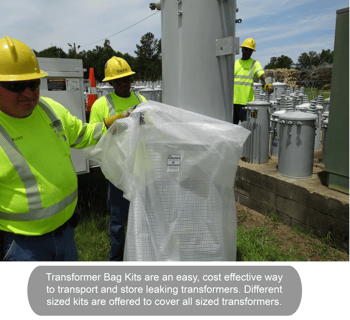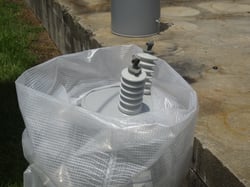The aftermath of a major storm can leave many areas and infrastructure with extensive damage, including Transformers. Transformers are susceptible to damage from high winds and flooding, so any damaged Transformers must be replaced safely and quickly to get power restored to affected areas. Doing this is essential to protecting property and preventing additional damage from occurring.
When Transformers are damaged, it can result in a range of issues. In some cases, the transformer may suffer mechanical damage that can cause it to malfunction. This could lead to sparks or arcing electricity, which can be highly dangerous and create fire hazards. Damaged transformers also risk leaking hazardous chemicals like oil, sulfur hexafluoride, or other dielectric fluid. To prevent and mitigate these risks, you will need to take steps to protect the Transformers from further damage, or the environment from their spills. Using specialized equipment like Transformer Bags or other clean-up tools are a must-have tool for quick and safe transport.
How to Protect Transformers from Inclement Weather and Wear
Take steps to properly dispose of any waste generated when cleaning up damaged Transformers – this includes oil spills which can contaminate soil and groundwater if left unchecked.
Taking these steps will help ensure that damaged Transformers remain safe following a bad storm or natural disaster. Clean up properly after storms so that Transformers can return to their intended purpose of providing power for households across the country without interruption due to faults caused by harsh weather conditions like floods and strong winds!
What are the risks presented by a damaged Transformer?
Transformers are essential parts of the power grid, providing power to homes and businesses across the country. However, they are vulnerable to damage from storms, floods, earthquakes, and other natural disasters which can cause them to malfunction, which presents a serious safety risk not only to those working on them but also to communities living nearby.
Damaged Transformers can release hazardous materials into the environment such as polychlorinated biphenyls (PCBs), which have been linked to cancer in humans. Transformers also release a flammable gas called SF6 during their operation; if this gas is not kept below levels set by the Environmental Protection Agency (EPA), it could ignite and lead to an explosion. Transformers that contain copper may also leak oil containing sulfuric acid when damaged, creating corrosive vapors that can be dangerous to inhale.
What do you do with a damaged Transformer?
 Dealing with a damaged Transformer can be a daunting and dangerous task. Transformers are housed in sturdy metal boxes and contain large amounts of electricity, making them both hazardous to people and property. Safety measures must be taken when dealing with Transformers that have been damaged due to storms, earthquakes, or any other natural disaster. Here are a few tips for how to safely clean up Transformers after a disaster.
Dealing with a damaged Transformer can be a daunting and dangerous task. Transformers are housed in sturdy metal boxes and contain large amounts of electricity, making them both hazardous to people and property. Safety measures must be taken when dealing with Transformers that have been damaged due to storms, earthquakes, or any other natural disaster. Here are a few tips for how to safely clean up Transformers after a disaster.
The first step is to inspect the transformer for any signs of damage, such as cracks or bends in the housing or broken parts inside. If the transformer is still operable, it is important to keep it isolated from other electrical equipment and make sure all wiring is secure. Transformers should never be used if they show signs of significant damage.
Second, when cleaning Transformers that have been exposed to floods or heavy rains, they must be washed thoroughly with clean water right away. This will help prevent further corrosion of the metal case and protect internal components from shorting out during operation. Spill protection should also be considered when dealing with Transformers. Depending on the type of Transformer, you may need specialized oil-absorbent materials like pads and booms to contain the spillage until it can be cleaned up and disposed of properly.
Finally, take steps to ensure Transformers are returned to their intended purpose once they are no longer needed for temporary storage following a disaster; disposal must adhere to all local laws concerning hazardous materials as well as environmental regulations regarding air emissions, groundwater contamination, and proper dumping procedures for transformer waste materials like oil containers and coolant tanks. One way to effectively transfer damaged Transformers to a disposal site is to move them into some kind of container, like a specially made bag.
 Transformer Bags provide a cost-effective solution for transporting and storing Transformers that have been affected by storms, floods, or other natural disasters. These bags are made of multiple layers of heavy fabric with cord reinforcement to resist punctures and tears. Built from UV-stabilized material to protect against degradation due to extended exposure to sunlight, and cold-crack resistant to prevent failure in extremely cold temperatures, Transformer Bags are lightweight and flexible for easy handling and quick use. Transformer Bag kits offer an effective solution for protecting Transformers from further damage and ensuring that hazardous materials are contained.
Transformer Bags provide a cost-effective solution for transporting and storing Transformers that have been affected by storms, floods, or other natural disasters. These bags are made of multiple layers of heavy fabric with cord reinforcement to resist punctures and tears. Built from UV-stabilized material to protect against degradation due to extended exposure to sunlight, and cold-crack resistant to prevent failure in extremely cold temperatures, Transformer Bags are lightweight and flexible for easy handling and quick use. Transformer Bag kits offer an effective solution for protecting Transformers from further damage and ensuring that hazardous materials are contained.
Dealing with damaged Transformers after a natural disaster requires caution and careful attention to avoid further damages or even injuries caused by these hazardous pieces of equipment. Taking proper safety precautions such as cleaning up Transformers immediately after exposure to floodwaters, securely anchoring them in outdoor storage areas, using spill protection materials in cases where necessary, and disposing of waste materials according to local laws will help ensure damaged Transformers remain safe until they can return to their intended purpose.
 Transformer Bags can also be used as covers for Transformers stored outdoors; the fabric resists tearing and provides extra insulation for Transformers exposed to extreme temperatures or direct sunlight. Additionally, many Transformers have metal enclosures that can corrode if exposed to water or moisture; the extra layer of protection provided by Transformer Bags helps prevent corrosion and extends Transformers’ lifespan.
Transformer Bags can also be used as covers for Transformers stored outdoors; the fabric resists tearing and provides extra insulation for Transformers exposed to extreme temperatures or direct sunlight. Additionally, many Transformers have metal enclosures that can corrode if exposed to water or moisture; the extra layer of protection provided by Transformer Bags helps prevent corrosion and extends Transformers’ lifespan.
Transformer Bag Kits are an easy way to ensure Transformers remain safe from damage during shipment or storage. They provide a secure, cost-effective solution that helps protect Transformers from spills, leaks, and extreme temperatures while providing additional insulation in outdoor environments. Transformers will continue providing power safely when they are properly protected with Transformer Bag Kits! By following these simple steps, you can be sure Transformers remain safe and compliant with local regulations even in the harshest of weather conditions.
Be Ready for the Next Storms
Transformer Bags and other cleanup tools are what make preparing for future storms essential, so keeping Transformers safe from weather damage or replacing damaged ones is an easy process. Not only do these bags provide insulation against extreme temperatures, but also offer protection from spills and leaks. Having the right spill protection materials in place before a storm hits can help avoid any hazardous waste material from damaging property or people nearby. With these and other precautions in mind, you can be prepared for any storms that may arise while ensuring your transformer is compliant with local regulations and providing power safely!


